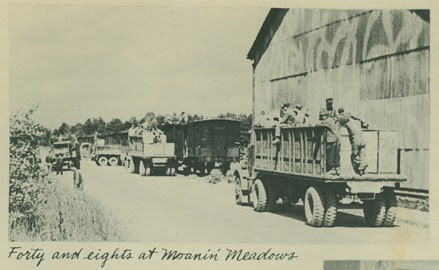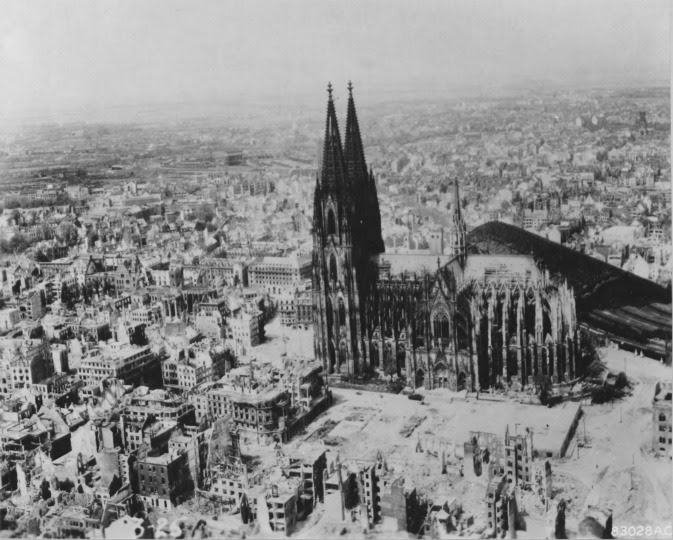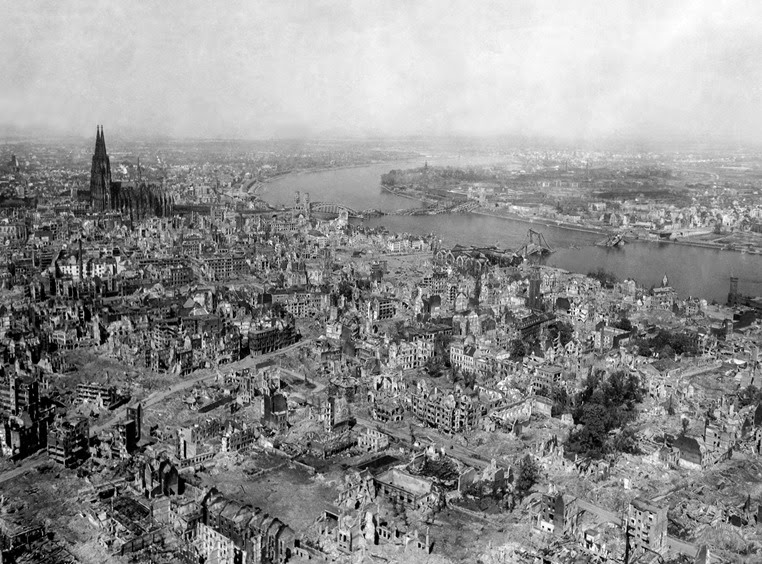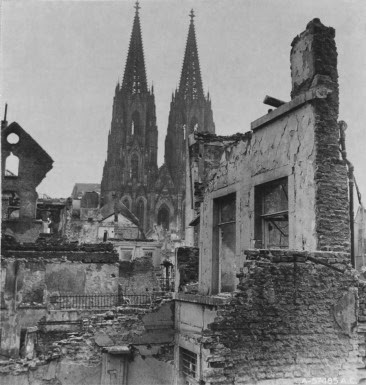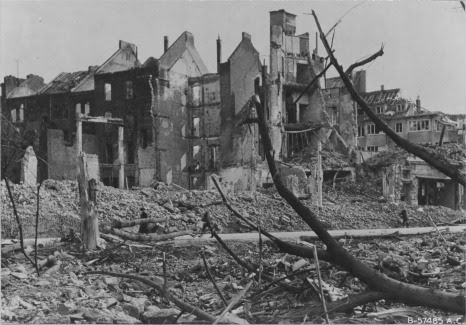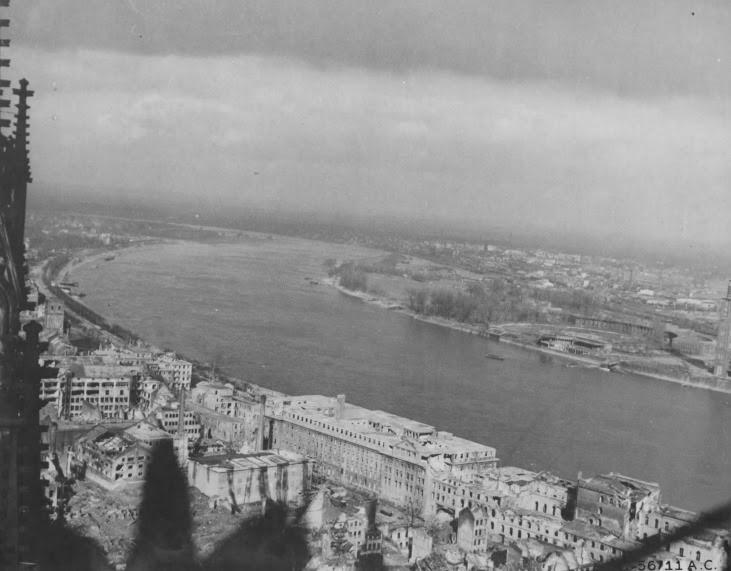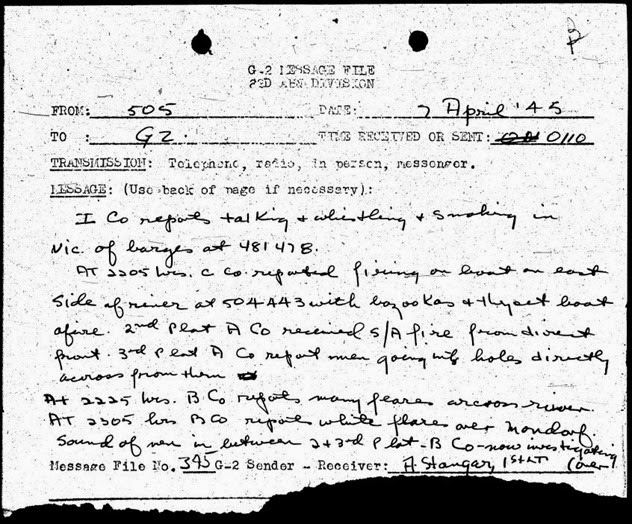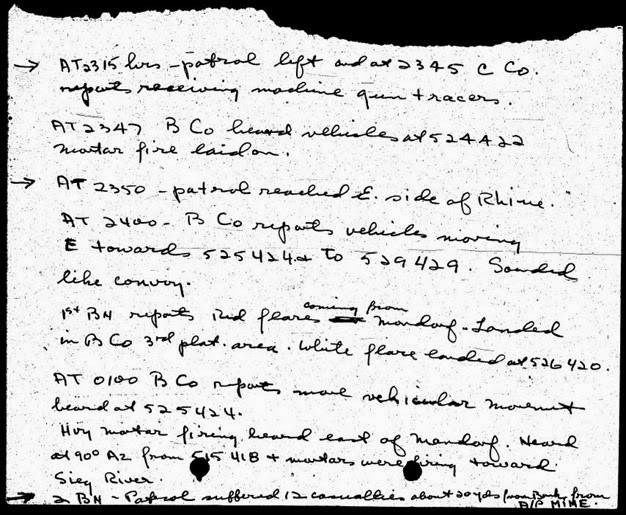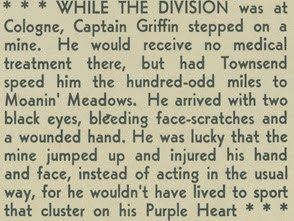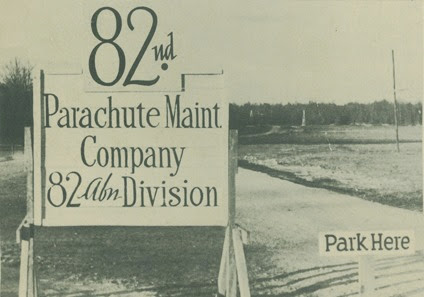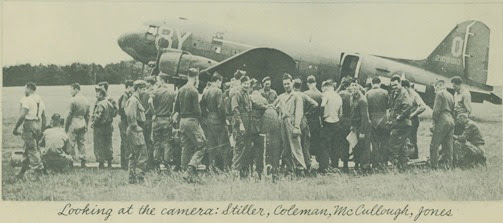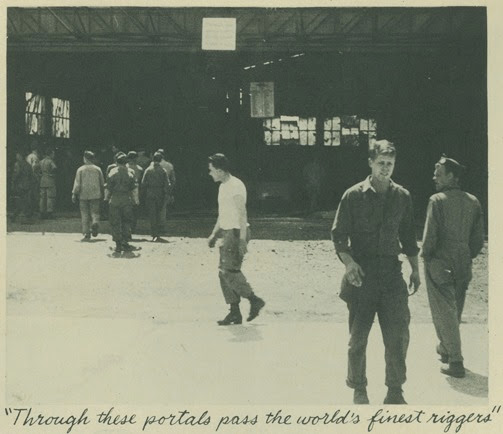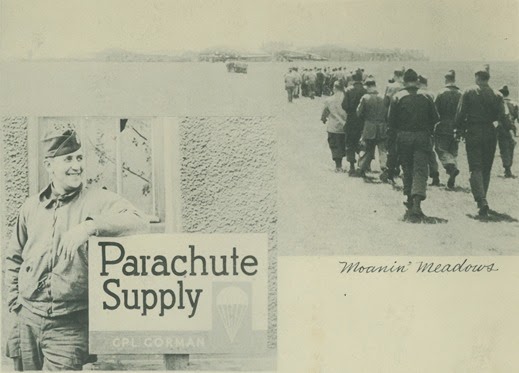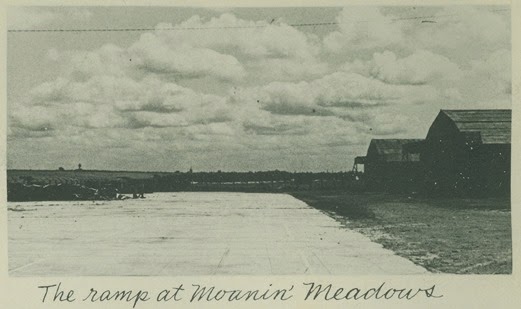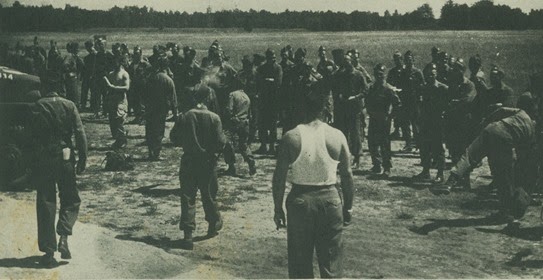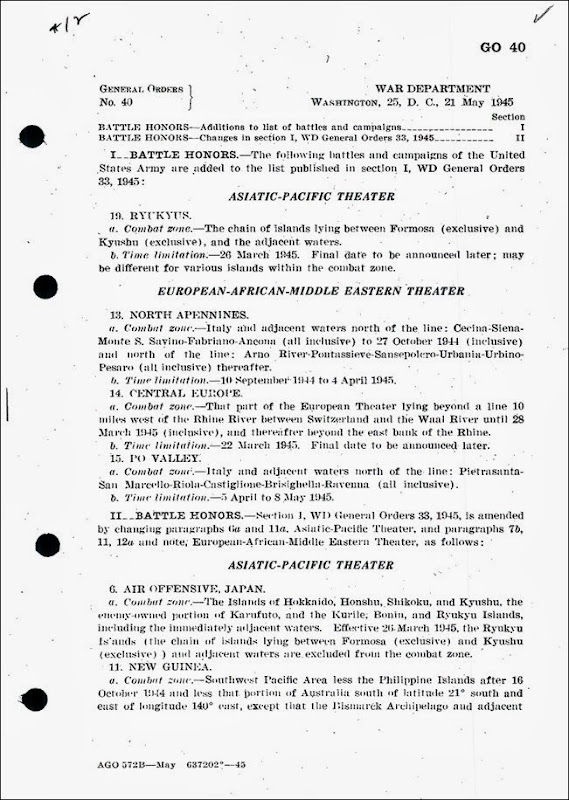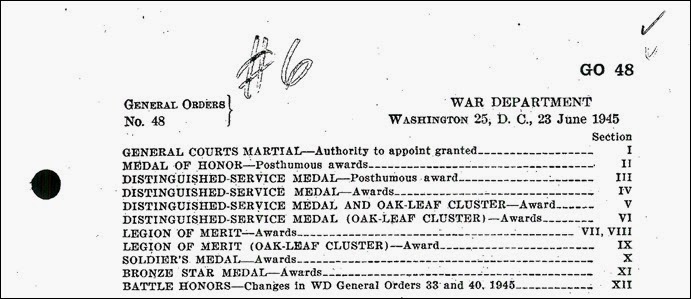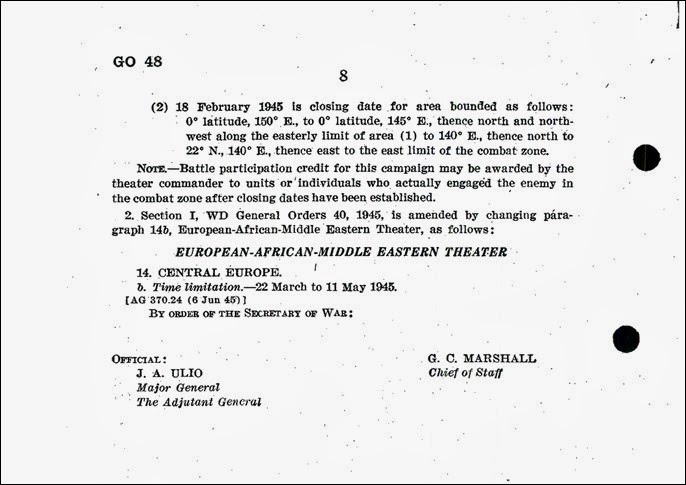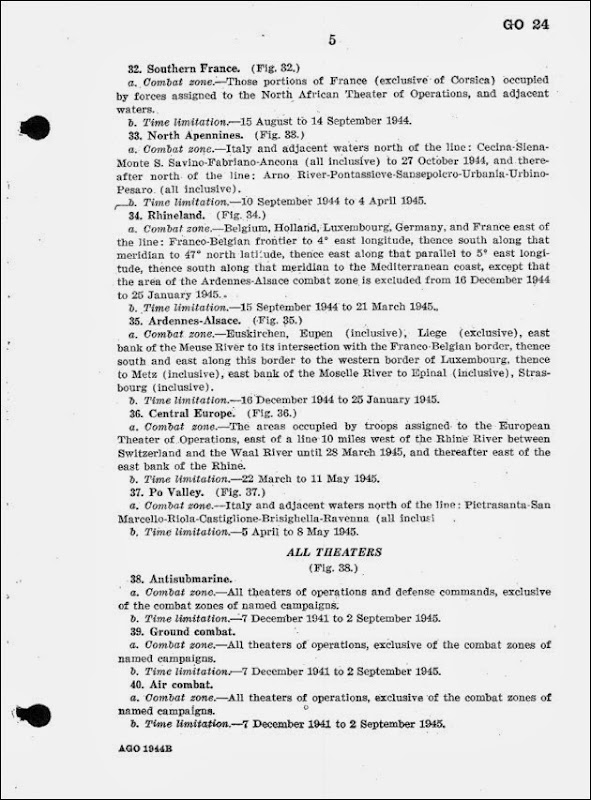The 82nd Airborne Division Moves Out for the Rhine River
The 82nd Airborne’s mission in the Central Europe Campaign began with orders to advance on the Rhine River. They were to plug a hole in the front lines at Cologne Germany, through which enemy forces trapped in the ‘Ruhr Pocket’ could have conceivably staged a westward breakout.
On April 2 1945, the Division’s units set out via rail and truck from their bases around Reims, France. At Stolberg Germany, in a lengthy process that took the whole day of April 3, the rail-borne units debarked one trainload at a time because there was only a single siding at the Stolberg railhead. The truck-borne units ended their journey at the Modrath truckhead at midnight on April 2. On the same day, Division Headquarters was established in Weiden, a few miles west of Cologne, Germany. (Click on the lines and icons in Map 1 below for these movements and place names.) Source: Author Unknown, “After-Action Report 82nd Airborne Division April 1945”, 1945 p. 2-3
Photo 1: 82nd PMC Riggers loading equipment on to “Forty and Eights” trains before moving out for Cologne Source: “Our Outfit: The Story of the Parachute Riggers of the 82nd Airborne Division” unpublished manuscript p. 90. Author’s collection.
View 82nd Airborne Routes to Cologne from French Base Camps in a larger map
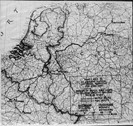 Click the map to see it in a larger format
Click the map to see it in a larger format
Original Map 82nd Airborne route from France to Cologne area Germany April 2 – 3 , 1945 Source: Annex No 2 to 82nd Airborne Division Historical Narrative For April 1945 Rhine River Defense Map
The initial objective was for the 325th GIR, 504th and 505th PIRs to relieve the US 86th Infantry Division of its defense positions over a distance of about 32 miles on the Rhine River’s west bank in the vicinity of Cologne. This was achieved by 11:30 PM on April 4. Artillery units of the division then began fire to interdict the enemy’s positions on the east side of the River. The 504’s sector extended north from the outskirts of Cologne (Koln). The 325 was stationed in Cologne and the 505 was spread south from the right flank of the 325 south towards the city of Bonn. (Click on the lines and icons in Map 2 below for these positions and place names.) Source: Author Unknown, “After-Action Report 82nd Airborne Division April 1945”, 1945 p. 1-2
View Division of Cologne (Koln) between 82nd Abn Units in a larger map
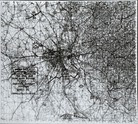 Click the map to see it in a larger format
Click the map to see it in a larger format
Original Map 82nd Airborne Rhine River Defense of Cologne (Koln), Germany April 4 – 16, 1945 Source: Annex No 3 to 82nd Airborne Division Historical Narrative For April 1945 Rhine River Defense Map
The 82nd Airborne Parachute Maintenance Company in Cologne
As their unpublished history indicates, the 82nd PMC was among those Division units sent to Cologne on April 2:
“…The rush in the packing and maintenance sections ended as soon as Division was committed as ground troops at Cologne.
Shortly before this, 20 men were transferred back to their original organizations.” Source: Author Unknown, “82nd Airborne Division: 82nd Parachute Maintenance Company”, Section 1 Unit History, Date unknown, p. 13.
The units to which these 20 men belonged to originally were the 504 and 505 PIRs. They were transferred back to their original regiments prior to the Division’s departure on April 2 when the 82nd was making preparations to depart for the defense of the Rhine River in the area around Cologne. These men were assigned to combat companies in the 505th and 504th, just as they had been in the airborne campaigns of Sicily, Italy, Normandy, and Holland. They were to fight with these companies in Cologne. Some 34 508 PIR riggers were still being used in parachute maintenance even after their regiment had been detached from the 82nd. They were not members of the new 82nd PMC and so could not have been part of this transfer. Source: Author Unknown, “82nd Airborne Division: 82nd Parachute Maintenance Company” Section III Unit Statistics, Date unknown, p. 3.
The 508th was sent to Chartres, France on April 4. They moved back to Sissonne on June 1, 1945 and shortly thereafter were ordered to Frankfurt to be General Eisenhower’s honor guard. Source: “Nordyke, P. “Put Us Down In Hell: The Combat History of the 508th Parachute Infantry Regiment in World War II” 2012, pp. 484 – 489.
Besides those riggers transferred back to the 504 and 505, the 82nd PMC itself was present for duty with the Division in Germany for April and May, before returning on June 1, 1945. Source 1: Author Unknown, “After-Action Report 82nd Airborne Division April 1945” p. 7 . Source 2: Author Unknown, “After-Action Report 82nd Airborne Division May, 1945” Annex 1 .
Indeed, the 82nd PMC played a part in the Division’s mission along the Rhine:
“The 82nd Military Police Platoon and the 82nd Reconnaissance Platoon were ordered on April 10 to begin a search of rear areas. Some of the division units, such as the 407th Airborne Quartermaster Battalion, the 762nd Airborne Ordinance Maintenance Company, and the 82nd Parachute Maintenance Company [emphasis added] were assigned occupation duties. These consisted primarily of guarding bridges, power plants, and other infrastructure in the areas to the rear of the infantry regiments, to protect them from sabotage.” Source: Nordyke, P. “All American All the Way: The Combat History of the 82nd Airborne Division in World War II”, 2005, p. 741
While the whole Division including the 82nd PMC went to Germany to fight during April and May, some 82nd PMC troopers stayed behind at Reims, and others returned prior to the Division’s June 1st date of return. These men and were present in Sissonne with men from other 82nd units for a VE-Day parade on May 8, 1945. Source: Unpublished manuscript “Our Outfit: The Story of the Parachute Riggers of the 82nd Airborne Division”, p. 78 . Author’s collection.
The city of Cologne as Experienced by the Men of the 82nd Airborne Division in April, 1945
Photo 2: The grand Cologne Cathedral stands out conspicuously across the bombed cityscape. Source: fold3.com
It was spared a direct hit receiving only superficial damage despite the 42,000 tons of bombs dropped by Allied planes on Germany’s forth largest city.
Photo 3: The Allied bombing campaign on Cologne left a ruined city source: Wikipedia Commons
Photos 4 & 5: Close-up aerial views of Cologne bomb damage . Sources: fold3.com (Click for larger pictures)
Photos 6 & 7: Close-up ground views of Cologne bomb damage . Sources: fold3.com (Click for larger pictures)
Bill Clark’s Assignment in Cologne
Bill’s brother, Henry Clark Jr. was assigned to the 47th Liaison Squadron which between September 17, 1944 and May 1, 1945 was stationed near Verdun, France. They were housed in Fort Bevau, a complex of stone buildings. They shared the fort with the 78th Ordinance Battalion which repaired tanks. Source: Clark, H. “The War I Never Fought: WWII Memoirs of a ‘Rear Rank Rudy’” 2001 pp. 88 – 89.
While stationed there, Henry wrote home on April 8, 1945 saying he thought Bill was in Cologne:
“Dear Folks,
There isn’t much to report from this end. I’m doing alright. Haven't heard or seen anything of Bill since I saw him Mar. 20th. He was at Reims then but I think he may be at Cologne now…” Source: Henry Clark Jr. Letter dated April 8, 1945
On March 20, about 13 days before the 82nd moved out for Cologne, Henry drove up from his station near Verdun and picked Bill up. The two brothers drove back to Henry’s base to visit:
“My brother had some time off so I drove to Rheims and picked him up [They drove back to Verdun]. It was a short two day visit. We had a little party as usual to break the monotony of military life. I remember we bought some cognac from a Frenchman. It was nicely packaged in a wooden box. The ‘frog’ was having trouble getting it open. Impatiently my brother got hold of the ‘frog’s’ hatchet and deftly opened the box. The ‘frog’ was a little nervous but everything worked out all right with no broken glass. The cognac sold for two hundred francs a bottle. The following afternoon I took Bill down to the flight line and got him a ride back to Rheims in a liaison plane that happened to be going that way. Slim the cook came down to our barracks and finished off the bottle of cognac. I think we were a bunch of drunks back then.” Source: Clark, H. “The War I Never Fought: WWII Memoirs of a ‘Rear Rank Rudy’” 2001 p. 98.
Bill’s service record indicates that earned a Bronze Service Star (AKA a Battle Star) for the Central European campaign which confirms Henry’s belief at the time that Bill went with the Division to Cologne. For more information on the qualifications for receiving campaign credit for the Central Europe campaign see the Appendix at the end of this post.
Bill’s Recollections of Night Patrol Duty on the Rhine River, Cologne
It is clear the 82nd PMC was called with the Division to fight in Germany and Bill was with the Division in Cologne. As we will see below, he was most likely assigned to the 505th PIR in a combat battalion stationed on the Rhine River defending the western bank.
Photo 8: Before the cathedral in Cologne and a knocked out German Panther tank, an 82nd Airborne Corporal stands next to a sign which evocatively reads:
“SIGHT SEEKERS KEEP OUT! Beyond this point you draw fire on our FIGHTING MEN. HE RISKS HIS LIFE 24 HOURS A DAY. DO YOU??”
Source: Wikipedia Commons
After the war Bill told his friend and lawyer, Herd Bennett, some of his experiences in the Central Europe campaign. Source: Herd L. Bennett, Attorney at Law,“Military Biography of William A. Clark” January 26, 2000 p. 20 - 21.’
He said that in Cologne he volunteered for patrol duty in a boat on the Rhine River over several nights. The objective of these patrols was to take a row boat from the west bank of the Rhine River, with several other men, to reconnoiter German positions on the east bank:
“…[Bill] decided to volunteer to go on several night patrols in a rowboat across the Rhine River to reconnoiter German positions. On one of these patrols, his boat’s assignment was to capture a German officer. Bill specifically recalls that on 2 patrols his boat passed within 20 – 30 feet of a rowboat full of German soldiers going in the opposite direction, itself reconnoitering American positions. He states that on both of these occasions these boats passed each other with him and the Americans pointing guns at the Germans and the Germans pointing guns at Bill and his buddies. Neither side ever fired a shot. I asked Bill if there was any particular reason for this lack of gunfire and he said, ‘Sure – no one wanted to die – them or us. If we could have slipped a grenade into their boat before they opened up on us that would have been different, but their boat was too far away to do this without being observed.’Source: Herd L. Bennett, Attorney at Law,“Military Biography of William A. Clark” January 26, 2000 p. 20 - 21.
Chronology of 82nd Division’s Patrol Duty on the Rhine River April 1 – 16, 1945
On April 1 orders regarding the patrols across the Rhine River had been given to the effect:
“…that patrolling along the Corps front would be ‘intensified beginning night 2-3 April to the extent of not less than one patrol per front line battalion per night.’ [and] …‘Within the discretion of the Regimental Commander, up to one rifle company may be left on the far bank of the RHINE River to screen, observe, and report on enemy activity.’” Source: Author Unknown, “After-Action Report 82nd Airborne Division April 1945” p. 2.
For units of the 82nd Airborne, it was not until the night of April 4/5 that patrols began:
“Two patrols of 325th Glider Infantry and four patrols of 504th Parachute Infantry crossed the RHINE River during the night of 4-5 April and made contact with enemy troops. One prisoner was taken.” Source: Ibid.
The 505 PIR also sent out patrols beginning the night of April 4/5. That night, Company E was assigned the first 505 PIR patrol. As soon as its boat landed on the eastern bank the men were met with heavy machine gun fire. In running for cover, they found themselves in a mine field where two men were killed. Source: Nordyke, P., “Four Stars of Valor: The Combat History of the 505th Parachute Infantry Regiment in World War II”, 2006, p. 390
Then on the night of April 5/6 three patrols captured two prisoners and a company sized patrol (Company A, 504 PIR) was sent across the river to seize the town of Hitdorf . The town was used as a strongpoint and a base for further patrols of the east bank by the 504 PIR on April 6. Subsequently, a counter attack of 60 infantry and two tanks was repelled. Sixty prisoners were captured in the process. Before their withdrawal on April 7, Company A destroyed a Mark IV tank and inflicted casualties on an enemy force when it attacked at around midnight. They themselves incurred six KIA, 14 WIA, and 26 MIA before withdrawing. Source: Author Unknown, “After-Action Report 82nd Airborne Division April 1945” pp. 2 - 3.
Company A 504 PIR later received the Presidential Unit Citation for their action at Hitdorf.
That same night a patrol of 505 PIR infantry incurred 12 casualties (50 percent of the patrol) when it stepped into a minefield on the east bank of the Rhine and became ensnared. Source: Author Unknown, “After-Action Report 82nd Airborne Division April 1945” p. 3.
Between April 8 – 16:
“No additional large patrols were sent across the RHINE River, due in part to strict rationing of artillery and mortar ammunition allotments, but the Division continued to improve its defenses and to send small patrols across the river until its positions were masked by attack from the South by XVIII Corps (Airborne) on the East side of the RHINE River.” Source: Ibid.
How Was Bill Assigned to Patrol Duty?
While it is unknown how Bill became assigned to patrol duty on the Rhine, the most logical explanation was that he was one of the 20 riggers transferred back to their original organizations, which in his case was the 505 PIR. The After Action Report for April, 1945 states that patrols were made by front line battalions at night. For Bill to be in a position to volunteer for a patrol of the eastern bank of the Rhine, he would have likely been assigned to a battalion in the 505. It is also possible, yet less probable, that he volunteered for patrols while being assigned duty in the 82nd PMC. He was one of the oldest serving men in the 82nd and had connections with sergeants and officers in the combat companies of the 504 and 505 PIRs. It is conceivable that he could have used these to get assigned to patrol duty with either regiment.
Why Volunteer for Patrol Duty Given its Risks in This Late War Period?
Death by bullet…
It is somewhat curious that he would want volunteer for these patrols since it quickly became apparent just how dangerous they were. Of course there was the risk of being wounded or killed by German artillery, or simply shot by German infantry, or their machine guns as the patrols crossed the river and made their way into enemy territory to observe their strength, defenses, positions, armor, and capture soldiers for interrogation.
Death by drowning…
Boats were prone to capsizing when surprised by enemy flare activity or gun fire. When a boat overturned men were forced to swim the 1000 yard (1 km) turbulent Rhine in its frigid spring flood causing several MIA and confirmed KIA due to drowning.
I made a visit to Bill with his brother Henry Clark at his rest home in 2003. We were all having a laugh at some story when a new nurse came into check on Bill. Recognizing that she had a German accent, Henry asked where in Germany she was from. She responded that she was from a small town on the Rhine River near Bonn. She asked Henry if he knew where the city of Bonn was located. Henry responded that he didn’t know exactly.
Bill then chuckled and proclaimed loudly, “He may not know, but I know where on the Rhine you’re from. I know all about the Rhine!”.
After a moment’s silence he added in earnest, “I couldn’t get over how cold that river was.”
Given this exchange, I wonder if Bill was in one of those boats that had capsized and whether he had to swim the Rhine as a result.
Death by Anti Personnel Mine…
These crossings were made even more hazardous because the Germans had mined the river. Several deaths and injuries were sustained when 82nd men stepped into mine fields on the German occupied eastern river bank. Many of these occurred in waist deep water as patrols waded ashore. The risk of stepping on a mine didn’t decrease with the passing of time because each day the Germans would lay fresh mines to replace those which had exploded and lay new mine fields in different locations.
To underscore the danger of river boat patrol duty:
“The [505th Parachute Infantry] regiment’s casualties for this period [of river boat patrols] were in excess of 30 men, killed and missing, and the greater number of the ‘missing’ were known to have drowned.” Source: Langdon, A., “Ready: A World War II History of the 505th Parachute Infantry Regiment”, 1986, p. 125
Addicted to Danger…
So why would anyone want to volunteer for patrols? In Bill’s case, over the course of the war, he had developed a history of volunteering. He volunteered to jump with the 504 PIR in Salerno. Later he volunteered for occupation duty in Berlin. Moreover, he undoubtedly enjoyed the danger patrols offered and the relief from boredom that came with the duty.
Danger was something paratroopers loved. When it was absent for too long they began to crave it. Gavin wrote of the phenomenon in his personal diary on April 13, 1945:
“As this thing approaches a wind-up I realize that I will have a frightful time adapting myself to the years of peace and ways of peace. Fighting and excitement have become my daily sustenance. I miss [them] after awhile.” Source: Lofaro, G., “The Sword of St. Michael: The 82nd Airborne Division in World War II”, 2011, pp. 535 – 536
Patrols by the 505th PIR 1st, 2nd and 3rd Battalions from April 7 – 9, 1945
Below are selected transcribed 505th PIR G-2 (intelligence section) messages files demonstrating the hazards of crossing the Rhine at night in the face of a determined enemy entrenched on the eastern bank; themselves actively patrolling the 82nd Airborne Division’s positions on the western bank.
Source: The MCoE HQ Donovan Research Library, Fort Benning, GA. Microfilm collection #: D 97 Item no. 2031 United States Army 82nd “All American” Airborne Division, Part A: G-2 journal and message file, 7-8 April 1945, Weiden, Germany. Retrieved from http://www.benning.army.mil/library/content/Virtual/Documents/Microfilm/index.htm Direct link: http://www.benning.army.mil/library/content/Virtual/Documents/Microfilm/film/D1-D630/D97_I2031.pdf (CAUTION: File size 362 MB)
Although there are no recorded G-2 intelligence messages from the 82nd of German and American patrols seeing one another in river boats, there were patrols of Germans active on the west bank of the Rhine from April 7 – 10, and within the time frames the 82nd night patrols were coming and going across the Rhine. Furthermore, a number of patrol messages are missing, others give spotty or incorrect details, some of which (but not all) are corrected in later messages.
It is plausible that some 82nd Airborne and German row boat patrols did see each other and it was not entered in a report.
Bill’s testimony, therefore, adds another previously unrecorded part to the history of the 82nd Airborne’s Rhine River patrols.
Photo 9: The Rhine River at Cologne from the west bank (circa March 23 1945). Source: fold3.com
The 1000 – 1200 yards (Approx. 1000 meters) wide Rhine River at Cologne. Its strong current is discernable even from the spires of the Cologne Cathedral where the photograph was taken. A hazard to traverse in rowboats, the river often proved a lethal challenge to swim.
Transcribed 505th PIR Airborne G-2 (intelligence section) message files from 7 – 9 April, 1945
The handwriting in many of the messages is difficult to read, so they have been transcribed to improve legibility. Here is a sample of one messages followed by its transcription. A further eight more messages are thereafter transcribed. They have been annotated to explain terms, acronyms, but not spelling mistakes, nor punctuation errors. Numbers such as ‘481478’ mentioned in the messages are map coordinates.
Page 1 of 505 PIR G-2 (AKA Intelligence) Message File, 7 April 1945 Source: G-2 journal and message file, 7-8 April 1945, Weiden, Germany, p. 11. Retrieved from http://www.benning.army.mil/library/content/Virtual/Documents/Microfilm/index.htm Direct link: http://www.benning.army.mil/library/content/Virtual/Documents/Microfilm/film/D1-D630/D97_I2031.pdf
Page 2 of 505 PIR G-2 (AKA Intelligence) Message File of 7 April 1945 Source: Ibid. p. 12
1. 505 PIR G-2 Intelligence Message # 345 for Rhine River Patrol, April 7 at 1:10 AM (Transcribed from Original Above)
| G-2 Message File, 82nd ABN Division FROM: 505 To: G2 DATE: 7 April ‘45 TIME RECIEVED OR SENT: 0110 |
| Message: “I Co. reports talking + whistling +smoking in vic. [vicinity] of barges at 481478. At 2205 hrs. C Co. reported firing on a boat on east side of river at 504443 with bazookas + they set boat afire. 2nd Plat A Co. received S/A [Standard Artillery] fire from direct front. 3rd Plat A Co. report men going into holes directly across from them. At 2225 hrs. B Co. reports many flares across river. At 2305 hrs. B Co. reports white flares over Mondorf. Sound of men in between 2 + 3rd Plat. B Co – now investigating.(over) At 2315 hrs. – patrol left and at 2345 C Co. reports receiving machine gun + tracers. At 2347 B Co. heard vehicles at 524422 mortar fire laid on. At 2350 – patrol reached E. side of Rhine. At 2400 – B Co. reports vehicles moving E. Towards 525424 to 529429. Sounded like convoy. 1st BN reports red flares coming from Mondorf. Landed in B Co. 3rd plat. area. White flare landed at 526420. At 0100 B Co. reports more vehicular movement heard at 525424. Heavy mortar firing heard east of Mondorf. Heard at 90 degrees AZ from 515418 + mortars were firing toward Sieg River. [The Sieg River is a tributary to the Rhine located north of Bonn, Germany] 2 BN – Patrol suffered 12 casualties about 20 yards from Bank from A/P [Anti Personnel] MINE.” |
| Message File No. 345 G-2 Sender – Receiver: A. Stangar 1st LT |
Source: Ibid. pp. 11-12
2. 505 PIR G-2 Intelligence Message # 340 348? (sic) for Rhine River Patrol, April 7 at 2:30 AM
| G-2 Message File, 82nd ABN Division FROM: 505 To: G2 DATE: 7 April ‘45 TIME RECIEVED OR SENT: 0230 |
| Message: “3rd Blue [3rd battalion patrol] under Lt. Prigchett landed at 469489 and investigated Trenches running from 471484. No ey [enemy] found dug outs and Trenches have been improved but not enough for occupation at night. Patrol then continued to investigate territory via 471484 road east of there. Patrol found dummy [unintelligible text] + dugouts on each bank of road [unintelligible text] and dug outs but do not appear to have been occupied at 473485 patrol ambushed 2 ey [enemy] and both were killed when they would not surrender – One knifed the other shot – both wearing regular Wehrmacht uniform such as regular German soldiers wear - (not parachute) Patrol returned (no identification pw [prisoner of war] bodys) The other patrols have not returned. |
| Message File No. 340 348? [sic] G-2 Sender – Receiver: Berkut , Maj. |
Source: Ibid. pp. 15 - 16
3. 505 PIR G-2 Intelligence Message #356 for Rhine River Patrol, April 7 at 2:45 AM
| G-2 Message File, 82nd ABN Division FROM: 505 To: G2 DATE: 7 April ‘45 TIME RECIEVED OR SENT: 0245 |
| Message: 2d Bn left 2215 from 489515 landed at 2227 at 498519 upon going ashore extensive AP mines approx 10 yards from bank. Someone tripped one (AP mine) results 12 casualties which was 50% of patrol. Came back. Landed at 2311. Left one body. 2 have died. 1st Bn having trouble. Picked up on radio now trying to get back to boats. |
| Message File No. 356 G-2 Sender – Receiver: White, S/Sgt. |
Source: Ibid. p. 22
4. 505 PIR G-2 Intelligence Message #351 for Rhine River Patrol, April 7 at 3:10 AM
| G-2 Message File, 82nd ABN Division FROM: 505 To: G2 DATE: 7 April ‘45 TIME RECIEVED OR SENT: 0310 |
| Message: B Co reports SA [Standard Artillery] fire hand grenades across River approx same place as out patrol was scheduled to be (0220) Sig [signal] lights observed across R [River] 3 shorts + ONE Long repeated in few minutes. At 0220 hrs. red flare from SAME POSITION. At 0230 one flare from other side of River. And in few minutes one [an enemy flare] from our side in B Co Area thought to be ey [enemy] patrol investigating. |
| Message File No. 351 G-2 Sender – Receiver: White, S/Sgt. |
Source: Ibid. p. 17 - 18
5. 505 PIR G-2 Intelligence Message #357 for Rhine River Patrol, April 7 at 5:00 AM
| G-2 Message File, 82nd ABN Division FROM: S-2 505th Prcht Inf To: G-2, 82d Abn Div DATE: 7 April ‘45 TIME RECIEVED |
| Message: “I” Co reported a call for help in English from approximately 484478 at 0345. At 0415 “I” Co reported this man was trying to swim the river. He was carried downstream and they could not hear him any more. They think he must have drowned. At the same time he was yelling for help from the middle of the river some more men were calling for help from about the same place. The 1st Bn still has 8 members of a patrol out. Five patrol members returned with the boat, leaving the others on the enemy shore after the patrol was broken up during a fire fight. It is believed the distress class came from the lost members of the 1st Bn patrol. NOTE: At 505 S-2’s request, the 325th Inf was notified to be on the lookout for the man whose body apparently floated downstream. Received by Strother. |
| Message File No. 357 G-2 |
Source: Ibid. p. 23
6. 505 PIR G-2 Intelligence Message #364 for Rhine River Patrol, April 7 at 7:15 AM
| G-2 Message File, 82nd ABN Division FROM: 505 To: G2 DATE: 7 April ‘45 TIME RECIEVED OR SENT: 0715 |
| Message: 1st Bn Patrol Report: 1 officer + 12 EMs [Enlisted Men] Time left: 2315 Time return: 0342. No PWs [Prisoners of War]. 3 men returned. Left from 519419 at 2315 hrs. Crossed to island, from island to E [East] bank of R [River] at 513429 at 0045 hrs. Split in 2 patrols. Proceeded to improved road past house via 517427 to village 515933. No activity in village. Fire fight at house at CR515431. 1 ey [enemy] killed. Armored car activity via house 517417. Reassembled on dyke at 515429, captured 2 PWs [Prisoners of War] 25 yards offshore flare caused boat to capsize when occupants tried to avoid flare. 3 men reached W [West] bank. No news of others + PWs” |
| Message File No. 364 G-2 Sender – Receiver: Miles, 1st Lt. |
Source: Ibid. p. 37
7. 505 PIR G-2 Intelligence Message # 457 for Rhine River Patrol, April 8 at 4:55 AM
| G-2 Message File, 82nd ABN Division FROM: 505 To: G2 DATE: 8 April ‘45 TIME RECIEVED OR SENT: 0455 |
| Message: B Co holding 2 civilians picked up with phony passes to Cologne. Civilians picked up by Belgium Fusilliers at approximately 0200. C Co reports unidentified boat going down stream at 0245 under fire from enemy side of river. Boat disappeared between OP [Observation Post] 6 & 5 C co area. D Co reports flashes of light seen around F Co position. E Co reports enemy patrol in 1st Plat area at 0320. Picked up by listening post, Headed for Lt. Drapers position. E Co notified Draper that enemy headed in his direction. 1st Platoon of E Co out looking for patrol. |
| Message File No. 457 G-2 Sender – Receiver: [unintelligible text – possibly ‘Miles’], 1st Lt. |
Source: Ibid. pp. 121 - 122
8. 505 PIR G-2 Intelligence Message # 585 for Rhine River Patrol, April 9 at 3:30 AM
| G-2 Message File, 82nd ABN Division FROM: 505 To: G2 DATE: 9 April ‘45 TIME RECIEVED OR SENT: 0330 |
| Message: 0210 German Patrol landed in front of E Co position. Set off booby traps and were fired on. Believed to be three men. E Co still conducting search. 0210 D Co heard sound of hobnailed boots in their area. D Co sent up flares. Search being made. 0315 Ey [enemy] patrol fired on MG [machine gun] of E Co. Gunners saw men fall but were gotten into boat. Patrol withdrew to other side [East bank of Rhine]. Return fire came from MG [machine gun] from 475497. Mortar fire being laid on that position. Patrol landed at 481507. Booby traps were set off by friendly search parties but no one hurt. |
| Message File No. 585 G-2 Sender – Receiver: [unintelligible text], 1st Lt. |
Source: Ibid. pp. 188 - 189
9. 505 PIR G-2 Intelligence Message # 627 for Rhine River Patrol, April 9 at 3:43 PM
| G-2 Message File, 82nd ABN Division FROM: 505 To: G2 DATE: 9 April ‘45 TIME RECIEVED OR SENT: 1543 |
| Message: |
| Message File No. 627 G-2 Sender – Receiver: [unintelligible text], 1st Lt. |
Source: Ibid. p. 222
Bill returns to Reims around April 17, 1945
On April 13, the 505 PIR obtained letters of surrender from mayors of Luledorf, Langel, Niederkassrl and Zundorf on the Rhine River’s eastern bank. Friendly troops had been advancing along the that side of the river and by April 16 they occupied all of the territory in front of the 82nd Airborne’s positions. Over April 14 - 15, with a shrinking line left to defend, the 504 and 505 PIRs and the 325 GIR had begun to assemble for their new duty – the occupation of Cologne from April 18 – 25. Source: Author Unknown, “After-Action Report 82nd Airborne Division April 1945” p. 3 - 4.
The 82nd Airborne’s zones of occupation in Cologne included the area of the city west of the River. The Division never occupied the eastern bank of the Rhine, and their only presence there was during patrol actions from April 4 – 16. Source: Anzuoni, R., “I’m the 82nd Airborne Division!: A History of the All American Division in World War II After Action Reports” 2005 p. 341 “Plate No. 3 Military Government Areas in Cologne Sector April – May 1945”.
At about the same time the 505 was relieved of manning the west bank of the Rhine, Bill was sent back to Reims.
Henry Clark Jr. wrote about it in a letter home dated April 22, 1945:
“Dear Mother,
…I saw Bill again (about 5 days ago) [i.e. about April 18]. He’s getting along fine said he had just written home. I wasn’t with him but about an hour.” Source: Henry Clark Jr. Letter dated April 22, 1945
Henry wrote about the visit in more detail in his book:
[On or close to April 18] “I went down to the flight line and ran into Bart Foster, liaison pilot. We used to fly together when we were at Gainsville [Texas]. I took a ride with him once in a while. I asked him to take me to Suippes so I could visit my brother. He had no flights at the present so we were off. About an hour later we set down at our destination and soon found him [Bill] in there packing parachutes. Bart took him [for] a ride and we visited a little while, then we were on our way back to Verdun.” Source: Clark, H. “The War I Never Fought: WWII Memoirs of a ‘Rear Rank Rudy’” 2001 p. 102.
Bill was not the only 82nd PMC man to be sent back to Reims. The unpublished rigger account “Our Outfit” records an incident involving the 82nd PMC commanding officer for April 1945, Captain Griffin:
Source: “Our Outfit: The Story of the Parachute Riggers of the 82nd Airborne Division” unpublished manuscript p. 78. Author’s collection.
In the 82nd After Action report for the month of April, 1945 Captain James E. Griffin is listed as the Commanding Officer of the 82nd PMC. After sustaining these wounds, the After Action report for May, 1945 lists Captain Wylie Cooper as the unit’s Commanding Officer. Source: Author Unknown, “After-Action Report 82nd Airborne Division May, 1945” Annex 1.
The interesting thing to note in Henry’s letter of April 22 is that he witnessed Bill rigging parachutes. The most likely reason for Bill’s return to Reims was to prepare for the inevitable exhibition jumps for dignitaries, generals and their armies once hostilities ceased. There were to be many such exhibition jumps after the war. Their main purpose was to impress upon the Russians the military might of the US and instill confidence across the western Allied occupation forces.
A large number of parachutes were needed. It is logical that veteran riggers would have been chosen for this task since mistakes resulting in unopened parachutes known as ‘streamers’ and subsequently dead paratroopers would reflect very poorly on the occupying American forces in the eyes of the Russians in particular. Bill and probably other veteran 82nd PMC men were likely sent back to Reims to complete this important mission. Near to the end of April Bill was either given a break or his part had been accomplished.
Over the period of April 28 – 29, Bill received a 24 0r 48 hour pass from his station which he used to visit Henry at his base near Verdun.
View Visits between Bill based near Reims and Henry based near Verdun in a larger map
Map 3: The 82nd Parachute Maintenance Company Camp “Moanin’ Meadows” four miles southeast of Sissonne and some 100 miles west of Fort Bevau near Verdun where the 47th Liaison Squadron was based.
In a letter home dated May 4, 1945, Henry wrote:
“Dear Mother,
…We have made a little move and as you can see we are in Germany…Bill came down and stayed all night shortly before we left Verdun. We had a good time. I’m sure he’ll be coming home soon…” Source: Henry Clark Jr. Letter dated May 4, 1945
On May 1 Henry left Verdun for the 47th Liaison Squadron’s new station at Wiesbaden Germany. He arrived on May 3, 1945. The close proximity of Verdun to Bill’s base at Moanin’ Meadows was approximately 100 miles making visits relatively easy by ground transportation and much easier by air (about an hour’s flying time), which on that one occasion Henry had been able to arrange. The distance between Reims and Wiesbaden was 253 miles (407 km) which was substantially more difficult. Given the timing of his visit – just before Henry’s outfit pulled out – Bill must have made a special effort to see Henry before he departed. He must have known that this visit would probably be the last opportunity to see his brother for a long time – perhaps even the last until they saw each other at home in Ohio.
Scenes of the 82nd PMC Riggers at Camp Moanin’ Meadows
The 82nd PMC barracks was about 4 miles southeast of Sissonne. The area was known as Camp Moanin' Meadows. The main C-47 airfield serving the 82nd Airborne was across a field from the barracks. The rigging sheds were adjacent to the airfield. Source 1: “Our Outfit: The Story of the Parachute Riggers of the 82nd Airborne Division” unpublished manuscript p. 78. Author’s collection. Source 2: Author Unknown, “82nd Airborne Division: 82nd Parachute Maintenance Company” , Date unknown, p. 12
Photo 10: Entrance to the 82nd PMC’s location at Moanin’ Meadows Source: “Our Outfit: The Story of the Parachute Riggers of the 82nd Airborne Division” unpublished manuscript p. 81. Author’s collection.
Photo 11: Riggers watch an equipment demonstration in front of a C-47 at Moanin’ Meadows Source: “Our Outfit: The Story of the Parachute Riggers of the 82nd Airborne Division” unpublished manuscript p. 92. Author’s collection.
Photo 12: The rigging sheds at Moanin’ Meadows. The quotation at the bottom is a quotation of the words on the sign at center top Source: “Our Outfit: The Story of the Parachute Riggers of the 82nd Airborne Division” unpublished manuscript p. 89. Author’s collection.
Photo 13: Paratroopers of the 82nd PMC walk from their barracks across the Moanin’ Meadows field to the packing and maintenance sheds on the other side Source: “Our Outfit: The Story of the Parachute Riggers of the 82nd Airborne Division” unpublished manuscript p. 84. Author’s collection.
Photo 14: The packing and maintenance sheds on right of picture Source: “Our Outfit: The Story of the Parachute Riggers of the 82nd Airborne Division” unpublished manuscript p. 88. Author’s collection.
Photo 15: Riggers assemble for a formation at Moanin’ Meadows under their commander, Capt. James Griffin (pictured in the white undershirt facing away from the camera) Source: “Our Outfit: The Story of the Parachute Riggers of the 82nd Airborne Division” unpublished manuscript p. 93. Author’s collection.
© Copyright Jeffrey Clark 2014 All Rights Reserved.
Appendix
Bill’s Service Record and the Central Europe Campaign
Bill’s recollections of the Rhine River patrols in the vicinity of Cologne, Germany are reflected in his service record. His Honorable Discharge states under 33. Battles and Campaigns that he received a Bronze Service Star for the Central Europe campaign.
As noted in previous posts, photographic evidence was presented in the post Normandy Part 1: Establishing Bill’s Presence in the Invasion which demonstrated that his Honorable Discharge accurately reflects the number of campaigns in which he said he had participated. Photo 1 of that post shows pinned to his breast an Arrowhead Device as well as one Silver Service Star, in lieu of five Bronze Stars, and one Bronze Service Star. The six campaigns were Sicily; Naples-Foggia; Normandy; Rhineland; Ardennes; and Central Europe. In the first post on Normandy, it was mentioned these are not Bronze Star Medals, which were awarded for valor in combat. They are Bronze Service Stars (sometimes referred to as Bronze Battle Stars). Each one indicates that Bill was physically present for duty in the zone of combat during the time frames of the respective campaigns.
Eligibility for the Central Europe Campaign Bronze Service Star
In the case of Central Europe, the facts about Bill’s Bronze Service Star can be verified by General Orders 40 War Department 1945 (AKA GO 40 WD45) partly reproduced below:
Page 1 of General Orders 40 War Department 1945 (AKA GO 40 WD 45)
Source: “Maneuver Center of Excellence Libraries Donovan Research Library US Armor Research Library Historical General Orders/Special Orders Collection: General Orders 1945 copy 2” Retrieved from http://www.benning.army.mil/library/content/Virtual/General%20Orders/GeneralOrders/DAGO1945.pdf
Page 1 of GO 40 WD 45 state the conditions for receiving a Bronze Service Star for the Central European campaign:
| 14. CENTRAL EUROPE. a. Combat zone. – That part of the European Theater lying beyond a line 10 miles west of the Rhine River between Switzerland and the Waal River until 28 March 1945 (inclusive), and thereafter beyond the east bank of the Rhine. b. Time limitation. – 22 March 1945 . Final date to be announced later. |
The final date for the Central Europe Campaign was announced in General Orders 48 of the War Department 1945 (GO 48 WD45) published June 23, 1945. The change is reproduced below on page 8 and is 22 March to May 11 1945:
Page 1 (top portion) & Page 8 of General Orders 40 War Department 1945 (AKA GO 48 WD 45)
Source: “Maneuver Center of Excellence Libraries Donovan Research Library US Armor Research Library Historical General Orders/Special Orders Collection: General Orders 1945 copy 2” Retrieved from http://www.benning.army.mil/library/content/Virtual/General%20Orders/GeneralOrders/DAGO1945.pdf
Bill was back in Reims by April 18, 1945 and units of the 82nd Airborne on occupation duty in Cologne did not cross the Rhine River. Source: Anzuoni, R., “I’m the 82nd Airborne Division!: A History of the All American Division in World War II After Action Reports” 2005 p. 341 “Plate No. 3 Military Government Areas in Cologne Sector April – May 1945”.
Given the stipulations in GO 40 WD 45 with those clarified in GO 48 WD45, the only 82nd Airborne men who could have received campaign credit for Central Europe between April 4 – 16 were those who performed patrol duty on the east bank of the Rhine. These patrols meet the conditions of the GO 40 and 48 WD 45 because they included patrols beyond the east bank of the Rhine.
Since Bill left Cologne and did not return to the areas assigned to the 82nd Airborne on the east bank of the Rhine from April 25 until May 11, he was given credit for Central Europe as a result of his assignment to patrol duty on the east bank of the Rhine and environs beyond the bank.
The dates and borders of the campaigns for WWII went through several more minor iterations in GO 58, 67, 69, 75 and 105 of WD 45. They were were all finalized in General Orders 24 War Department 1947 (GO 24 WD 47) which have been reproduced in part below. This final version includes maps of all the campaigns with borders and time limitations. The campaign map for Central Europe has also been reproduced below.
Page 1 of General Orders 24 War Department 1947 (AKA GO 40 WD47)
Source: “Maneuver Center of Excellence Libraries Donovan Research Library US Armor Research Library Historical General Orders/Special Orders Collection: General Orders 1946 - 1947 copy 2” Retrieved from http://www.benning.army.mil/library/content/Virtual/General%20Orders/GeneralOrders/DAGO1946-47.pdf
Page 1 (top portion) & Page 5 of General Orders 24 War Department 1947 (AKA GO 24 WD47)
Source: “Maneuver Center of Excellence Libraries Donovan Research Library US Armor Research Library Historical General Orders/Special Orders Collection: General Orders 1946 - 1947 copy 2” Retrieved from http://www.benning.army.mil/library/content/Virtual/General%20Orders/GeneralOrders/DAGO1946-47.pdf
Page 41 of General Orders 24 War Department 1947 (AKA GO 24 WD47) showing the map of the Central Europe campaign.
After March 28 , 1945 the area 11 miles from the west bank of the Rhine River was not included in the Central Europe campaign.
Source: “Maneuver Center of Excellence Libraries Donovan Research Library US Armor Research Library Historical General Orders/Special Orders Collection: General Orders 1946 - 1947 copy 2” Retrieved from http://www.benning.army.mil/library/content/Virtual/General%20Orders/GeneralOrders/DAGO1946-47.pdf
© Copyright Jeffrey Clark 2014 All Rights Reserved.

